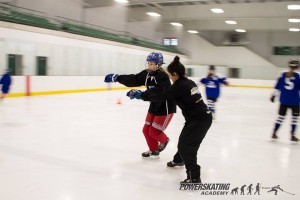On-Ice Training Trumps the Treadmill
 I’ve been asked many times about the increasingly popular method of hockey treadmill training. Initially introduced as a rehabbing tool for pro players coming off injury, the treadmill has now evolved into a training apparatus for all ages and levels.
I’ve been asked many times about the increasingly popular method of hockey treadmill training. Initially introduced as a rehabbing tool for pro players coming off injury, the treadmill has now evolved into a training apparatus for all ages and levels.
While I believe that great coaching is more important than the medium being used, and I do believe the treadmill could be a small part of a skaters training, it certainly should not be used as a method for learning how to skate.
Here are a few drawbacks of treadmill training:
Stopping
Since the ground is moving, stopping cannot be taught or practiced on the treadmill. Enough said.
Backwards Skating
Cannot be taught or practiced properly on a treadmill. A proper backwards stride starts off with an initial push off directly to the side with the heel turned out (closing the hip) and pressure on the ball of the foot. This is impossible to do properly with the treadmill moving at a set speed rather than you moving at your own controlled speed. Because the treadmill has a lot of resistance, weight gets pulled to the back of the skate instead of staying at the ball of the foot.
Cross Overs
Cross overs are taught on a treadmill as a straight line movement. The foot pushes and lifts over the opposing foot and lands on the other side. That lifting keeps your hips square to a straight line. A true cross over should be a push to an outside edge, with your foot circling around to an undercut a forward inside edge. Cross overs are an acceleration through a turn. Teaching that move properly is impossible to do when you’re forced to be in a straight line.
Edges
Edges cannot be properly taught on a treadmill. In order to properly teach an edge, it must be taught on a full or half circle. Since the ground is moving in a straight line on a treadmill, it’s impossible to do a circle or half circle.
The Science of Skating
If you’re looking to be a fast skater, the treadmill simply doesn’t train you to be one. When the treadmill elevates, players are forced onto the toe of their skate, which would ultimately slow them down in an on-ice situation. The more blade you have on the ice, the faster you will go.
Stride and Positioning
Proper stride requires that a player push their leg out outwards extending fully to the toe, however, while using the treadmill, players often have their leg pulled outward when practicing their stride. This means the treadmill ends up activating different stabilizer muscles and smaller muscles groups other than the ones used for proper on-ice strides.
On the treadmill, players are in a harness. That harness often helps compensate for wrong hip positioning and doesn’t get players to understand hip-knee-toe alignment.
Although the treadmill may achieve its purpose in being an effective rehabilitation tool, and be a useful tool for some players, it’s not an effective way to teach skating technique.
The treadmill simply cannot make a GREAT SKATER.

Recent Comments